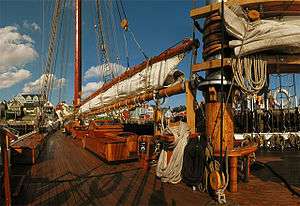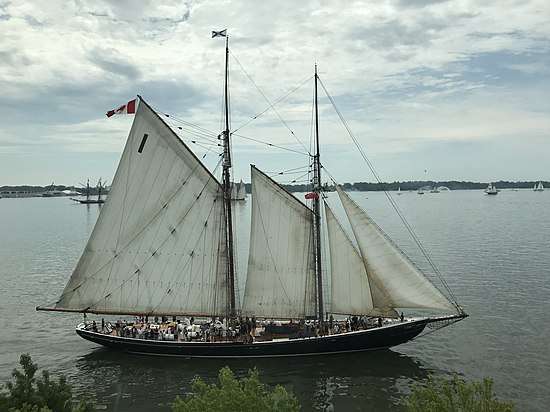Bluenose II
Bluenose II is a replica of the fishing schooner Bluenose, was commissioned by Sidney Culverwell Oland and built in 1963 as a promotional yacht for Oland Brewery. Sidney Oland donated the schooner to Nova Scotia in 1971 and it became Nova Scotia's sailing ambassador.
 Bluenose II in Lunenburg, 1 October 2003 | |
| History | |
|---|---|
| Name: | Bluenose II |
| Builder: | Smith and Rhuland |
| Launched: | 24 July 1963 |
| Identification: |
|
| Status: | in active service |
| General characteristics | |
| Tonnage: | 191 gross, 96 net[1] |
| Length: | |
| Beam: | 8 m (26 ft 3 in) |
| Draft: | 5 m (16 ft 5 in) |
| Propulsion: |
|
| Mainmast, height from deck | 38 m (124 ft 8 in) |
| Foremast, height from deck | 36 m (118 ft 1 in) |
| Sail area | 1,036 m2 (11,150 sq ft) |
| Mainsail area | 386 m2 (4,150 sq ft) |
| Speed: |
|
| Crew: | 5 Officers, Chief Cook, 12 Deckhands |
Construction
Bluenose II was launched at Lunenburg on 24 July 1963, built to original plans and by some of the same workers at Smith and Rhuland.[2] The original captain of Bluenose, Angus J. Walters, was consulted on the replica's design.[2] The replica was commissioned by Sidney Culverwell Oland for roughly $300,000 (2.4 million in 2018 Canadian dollars) as a marketing tool for their Schooner Lager beer brand.[2]
In 2004, the Bluenose Preservation Trust, with Lex McKay and Senator Wilfred Moore, donated a piece of wood from the deck of the ship to the Six String Nation project. Parts of that material now serve multiple functions in Voyageur, the guitar at the heart of the project,[3] including two elements of the neck laminate, the top and end blocks on the guitar's interior and decorative elements on the rosette surrounding the sound hole of the instrument.
Provincial ownership
Sidney Culverwell Oland sold Bluenose II to the government of Nova Scotia in 1971 for the sum of $1. After a number of years of managing the schooner directly, the province gave possession of the ship to the "Bluenose II Preservation Trust". The trust's mandate was to restore the aging schooner to full operational status and continue to operate her for the people of Nova Scotia. Over the winter of 1994–95 the ship's hull was restored and she was recommissioned in May 1995.
During this time Bluenose II was involved in the Sponsorship scandal when the federal government allocated $2.3 million for the schooner through a consulting firm but only a small amount of the money reached the vessel.[4] The trust maintained and operated Bluenose II until 31 March 2005, when the government of Nova Scotia placed the vessel under the management of the Lunenburg Marine Museum Society at the Fisheries Museum of the Atlantic. In a controversial move, the head of the trust, Senator Wilfred Moore, refused to release over $600,000 raised by the trust in the schooner's name to the current operators of Bluenose II.[5] Moore agreed to turn the trust's assets over to the province in July 2012, but did not release the financial records from the trust.[4]

Bluenose II serves as a goodwill ambassador and a tourist attraction in Lunenburg, and is symbol of the province. During the summer, she visits ports all around Nova Scotia and frequently sails to other ports on the eastern seaboard. The ship has one of the largest mainsails in the world, measuring 386 square metres (4,150 sq ft). She has a total sail area of 1036 m² (11,150 ft²). In honour of her predecessor, Bluenose II does not officially race. Funds for the operation of the ship are raised through charging for passage on the vessel, public donations, and sales in the Fisheries Museum Gift Shop (in Lunenburg), run by the Lunenburg Marine Museum Society.
Current rebuild
In May 2009, the provincial and federal government announced support for a major restoration of the Bluenose II. The project is valued at $14.8 million. In July 2010, the Nova Scotia government awarded a $12.5 million contract for the restoration of Bluenose II to a consortium of three Nova Scotia shipyards.[6] When the ship was finally relaunched in 2012, after major delays, the final cost was closer to 16 million dollars, just from the Nova Scotian government.[7]
This restoration was not without controversy. Tourism, Culture and Heritage Department sources stated that the restoration was "not intended to create an authentic replica of the original Bluenose" and that the builders would not be using the plans. Large portions of the hull were chipped while other small pieces were given away at the rebuilding site in Lunenburg NS. The masts, sails, booms, gaffs, deck boxes, rigging, and some ironwork will go back onto the vessel upon completion. This has led Joan Roue, a descendant of the first Bluenose's designer William Roue and current rights-holder of the design, to question whether this should even be considered the same ship.
As has almost all of the rest of the ship, even the keel has been remade.[8] It can be argued that Bluenose II had so many rebuilds and repairs over the years since she was built in 1963 by the Olands, that she has not been the same ship for quite some time. The current rebuild aims to have the schooner look more like the original Bluenose with smaller deckhouses and more deck space, as Bluenose II was built with yacht accommodation as opposed to the layout of a fishing schooner. Various subcomponents for this Bluenose II project were supplied from notable firms including the ships keel at Snyder's Shipyard in Dayspring, the ship's backbone of laminated ribs at Covey Island Boatworks in Riverport and assembly of the vessel in Lunenburg.
After more than 25 months of reconstruction, Bluenose II was relaunched into Lunenburg Harbor on 29 September 2012 from the Lunenburg marine railway followed by festivities at the nearby Fisheries Museum of the Atlantic, however due to repairs not completed, the vessel was pulled back onto land for more work. The vessel was returned to the water on 6 September 2013 and will undergo dock and sea trials before being handed over to the province for tourist duty. Retrofit costs to date are at least $19 million and the vessel still required modifications to its steering mechanism at an unknown additional cost.[9]
In the summer of 2016, Bluenose II renovations were completed.
See also
- List of museum ships
- List of schooners
- Museum ship
- Ship replica
- Ships preserved in museums
- Sunk cost fallacy
References
- Bluenose II, US Coast Guard Maritime Information Exchange
- Archives Staff (27 July 2004). "Bluenose II: The Legend Reborn (1963–1971)". Bluenose: A Canadian Icon. Halifax, Nova Scotia: Nova Scotia Archives. Archived from the original on 12 April 2013. Retrieved 23 July 2013.
- Jowi., Taylor (2009). Six string nation : 64 pieces, 6 strings, 1 Canada, 1 guitar. Vancouver: Douglas & McIntyre. ISBN 9781553653936. OCLC 302060380.
- McLeod, Paul (24 July 2012). "Nova Scotia yet to see Bluenose books". The Chronicle Herald. Halifax. Archived from the original on 27 August 2012. Retrieved 30 September 2012.
- Jackson, David (27 October 2011). "Former Bluenose II trust still hanging on to funds". The Chronicle Herald. Archived from the original on 2 May 2012. Retrieved 30 September 2012.
- Hoare, Eva (4 March 2010). "Three shipyards picked to restore Bluenose II". The Chronicle Herald. Archived from the original on 6 March 2010. Retrieved 14 December 2013.
- News Staff (7 July 2012). "Bluenose II refit months behind schedule". CBC News. Halifax. Archived from the original on 12 September 2012. Retrieved 29 September 2012.
- Hoare, Eva. "Just like the Bluenose, mostly" The Chronicle Herald, 23 December 2010.,
- "Bluenose II handed over to province, draws criticism from Tories", The Queens County Advance, 30 July 2014
External links
| Wikimedia Commons has media related to Bluenose II. |
- Bluenose II
- Bluenose: A Canadian Icon
- Bluenose II donated to Nova Scotia (1971 footage)
- Construction of a Bluenose II Replica model—A group of pictures which follows the construction of a highly detailed scaled wooden model of the Bluenose II.
- Bluenose II's Latest Reported Position from Sailwx